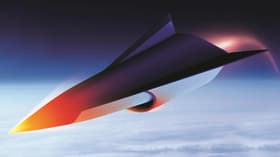| GE combină detonația rotativă și ramjet într-un nou motor hipersonic |
 |
 |
| Marţi, 19 Decembrie 2023 13:44 |
|
GE Aerospace a demonstrat ceea ce susține că este primul test de platformă hipersonic cu reacție dublu-mode Ramjet (DMRJ) din lume care utilizează arderea cu detonare rotativă (RDC) într-un flux supersonic care ar putea oferi într-o bună zi rachetelor hipersonice o rază de acțiune mai mare.
Hypersonic technology has the potential to revolutionize warfare in ways not seen since the development of supersonic flight. However, flying at over five times the speed of sound requires serious technological advances, including developing new materials and electronics that can withstand the high temperatures in the Mach 5+ realm as well as engines that can provide hypersonic vehicles with the means for sustained flight.
Currently, many hypersonic missile prototypes are what are called glide vehicles. That is, they are accelerated to a high altitude and speed, then attain hypersonic velocity by going into a dive. Only gravity and inertia from this point on provide motive power. It works, but this limits the maneuverability, range, and efficiency of the craft. Ideally, what's wanted is an engine that can propel a missile or other craft throughout most of its flight. This would eliminate the dive phase, allow the vehicle to fly consistently at lower altitudes, increase the range, and provide more maneuverability. To do all this, the missile would need something like a ramjet engine. That's all well and good, but ramjets that can handle hypersonic conditions don't do well at low Mach numbers, so the vehicle still needs to be accelerated by a booster rocket until it's fast enough for the engine to engage. To get around this, GE Aerospace's DMRJ uses the principle of RDC to operate at both lower and higher speeds. In RDC, fuel and air are introduced into a gap between two coaxial cylinders. When the mixture is ignited, it burns in a very special way. The combustion takes the form of a supersonic wave that travels around inside the gap. As more fuel and air are fed in at the top, the wave continues going around in the gap, producing more and more heat and pressure, and is forced down until it exits through the exit nozzle, creating thrust. The beauty of such a ramjet design is that the design is very simple without moving parts and is suitable for hypersonic flight because it can tolerate air flowing into the chamber at supersonic speeds. The new engine was demonstrated on a test rig at GE's Niskayuna facility in New York State. By combining the new design with the company's advances in high-temperature materials, high-temperature electronics, 3D printing, and thermal management technologies, the goal is to create a practical engine that can operate at both above Mach 5 and below Mach 3. It will also be smaller and lighter than comparable engines. * **__ Source: GE Aerospace |
























